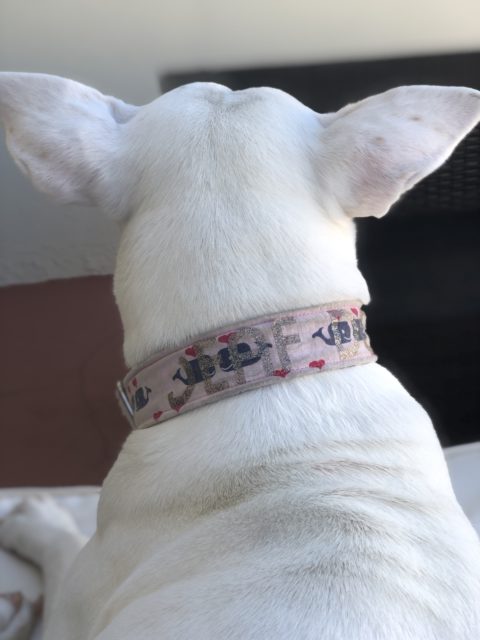Does your Deaf Dog Jump on People?
Does your deaf dog greet people by jumping up on them and would you like to change this behavior?
 Step one is to always avoid rehearsing the unwanted behavior. This may mean using a baby gate or a leash so that your dog doesn’t have the chance to practice the unwanted behavior–thus getting better at it.
Step one is to always avoid rehearsing the unwanted behavior. This may mean using a baby gate or a leash so that your dog doesn’t have the chance to practice the unwanted behavior–thus getting better at it.
The next step is to reinforce behaivors that you like which your pup already offers–such as four paws on the floor!
The final step is to separately teach an incompatible or an alternative behavior. This other behavior will ultimately become your dog’s default response to greeting people. This means that instead of meeting people and jumping up on them your dog will automatically resort to offering the new behavior (that you do like) for greetings.
To begin you will choose an incompatible or alternative behavior to teach your dog. This could be sit, lay down, or stand by your side.
The teaching process will be the same for whichever behavior you decide to teach.
-
- First you will set up the environment to “encourage” your dog to perform the behavior that you want. This can be done by A. watching and waiting for the behavior or B. luring your dog into a position using a bit of food (we’ll eliminate the food lure quickly).
- Next, you will “label” the behavior as it is occurring so that your dog begins to associate the (visual) cue with the behavior
- Be sure to mark and reinforce the behavior that you want to see repeated
- Eventually move to working in environments with higher distractions (building this slowly over time to set everyone up for success), with longer durations, and with closer proximities (more difficult level of distance) to people.
 For a concrete example of an alternative behavior that you might decide to each, take a look at the following plan. Let’s say you decide to teach your deaf dogs to sit on cue. You will start in a quiet room inside the house with nothing else going on (no other dogs, etc. to distract her). Then watch for her to offer a sit and as she’s sitting give the visual cue for “sit.” Be sure to do the visual cue as the behavior is occurring. Then, you want to mark—using your visual marker)—the second her bottom hits the floor. Finally, reinforce the behavior by tossing a treat. Tossing the treat will re-set her for another repetition/opportunity to practice the behavior.
For a concrete example of an alternative behavior that you might decide to each, take a look at the following plan. Let’s say you decide to teach your deaf dogs to sit on cue. You will start in a quiet room inside the house with nothing else going on (no other dogs, etc. to distract her). Then watch for her to offer a sit and as she’s sitting give the visual cue for “sit.” Be sure to do the visual cue as the behavior is occurring. Then, you want to mark—using your visual marker)—the second her bottom hits the floor. Finally, reinforce the behavior by tossing a treat. Tossing the treat will re-set her for another repetition/opportunity to practice the behavior.
Once she’s quite good as responding to the sit cue and you have begun to practice it in more distracting environments (such as outside or with another dog present) you can cue the behavior when she greets a person.
At this beginning stage you will still want to use management (leash or baby gate) to avoid the possibility of her practicing the unwanted jumping up behavior. Be sure to mark and reinforce the sitting behavior as it occurs. At this point you will deliver the reinforcer to her mouth (vs. tossing it as above) as you don’t want her to move away, but want to reinforce her remaining in the sit position.
Be sure to use high value (chicken, cheese, meatballs) reinforcers as you want your dog to be interested in “working” for the “payout!”
Finally, after many, many, many repetitions, instead of cueing the sit, have the person come close and wait. If your dog offers the sit behavior mark and reinforce multiple times—first for the sit and then for remaining in the seated position.
Your goal is to teach your dog that this alternative behavior is much more reinforcing than the previous unwanted (jumping) behavior was. You will do this by building a strong reinforcement history (sitting pays off!) so that your dog learns that it’s much more worthwhile to sit than to jump when greeting people!
For more help with your dog, contact us today! https://positiveanimalwellness.com/online-dog-training/
